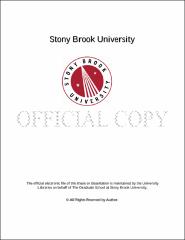| dc.identifier.uri | http://hdl.handle.net/11401/77114 | |
| dc.description.sponsorship | This work is sponsored by the Stony Brook University Graduate School in compliance with the requirements for completion of degree. | en_US |
| dc.format | Monograph | |
| dc.format.medium | Electronic Resource | en_US |
| dc.language.iso | en_US | |
| dc.publisher | The Graduate School, Stony Brook University: Stony Brook, NY. | |
| dc.type | Dissertation | |
| dcterms.abstract | A key challenge in the practical commercialization of PEMFCs is the extremely high cost and relatively poor durability of carbon supported Pt nanoparticle (Pt NP/C) electrocatalysts utilized in both the anode and cathode half-cells. Herein, we synthesize and characterize a new class of high-quality one-dimensional noble metal nanostructures as a potentially new and promising structural paradigm for the next generation of electrocatalyst materials. Specifically, we investigate the nature of the complex interplay amongst size, chemical composition, and electrocatalytic performance in high-quality elemental and bimetallic 1D noble metal nanowire systems with an emphasis on achieving efficient and sustainable methods for catalyst preparation. In terms of nanowire dimensions and composition, an interesting and measureable size-dependent enhancement in performance emerges in the case of elemental Pt, Pd, and Pd<sub>1-x</sub>Au<sub>x</sub> nanowires possessing diameters ranging from the submicron (d = ~200 nm) to the ultrathin regime (d = ~1 nm). In a similar context, we have considered the role of chemical composition in 1D electrocatalysts and noted significant composition-dependent enhancements in activity and durability in high-quality, bimetallic Pd<sub>1-x</sub>Au<sub>x</sub> and Pd<sub>1-x</sub>Pt<sub>x</sub> NWs. A key finding that is apparent from these experimental results is that widely seen behavioral trends in the composition- and size-dependent performance for 0D nanoparticle-based catalysts do not hold in the case of 1D architectures, because of the patently unique structural and electronic effects, associated with their anisotropic structures. As a culmination of our efforts to take advantage of these intrinsic structure-activity correlations, our group has developed a morphology-, size-, and composition-optimized Pd<sub>9</sub>Au NW possessing a Pt monolayer shell (PtML∼ Pd<sub>9</sub>Au NWs) electrocatalyst with an ultrathin 2 nm diameter, which yielded outstanding Pt mass and platinum group metal activities of 2.56 A/mg<sub>Pt</sub> and 0.64 A/mg<sub>PGM</sub>, respectively, thereby surpassing the activity of conventional state-of-the-art Pt NP/C by more than ten-fold. | |
| dcterms.available | 2017-09-20T16:51:59Z | |
| dcterms.contributor | Khalifah, Peter | en_US |
| dcterms.contributor | Wong, Stanislaus S | en_US |
| dcterms.contributor | White, Michael | en_US |
| dcterms.contributor | West, Alan. | en_US |
| dcterms.creator | Koenigsmann, Christopher | |
| dcterms.dateAccepted | 2017-09-20T16:51:59Z | |
| dcterms.dateSubmitted | 2017-09-20T16:51:59Z | |
| dcterms.description | Department of Chemistry. | en_US |
| dcterms.extent | 290 pg. | en_US |
| dcterms.format | Monograph | |
| dcterms.format | Application/PDF | en_US |
| dcterms.identifier | http://hdl.handle.net/11401/77114 | |
| dcterms.issued | 2013-12-01 | |
| dcterms.language | en_US | |
| dcterms.provenance | Made available in DSpace on 2017-09-20T16:51:59Z (GMT). No. of bitstreams: 1
Koenigsmann_grad.sunysb_0771E_11481.pdf: 10373296 bytes, checksum: 0611786a724020684a59c74d5a811565 (MD5)
Previous issue date: 1 | en |
| dcterms.publisher | The Graduate School, Stony Brook University: Stony Brook, NY. | |
| dcterms.subject | Chemistry | |
| dcterms.subject | Catalysis, Electrochemistry, Fuel Cell, Nanomaterials, Noble Metal, Oxygen Reduction Reaction | |
| dcterms.title | Designing a New Class of Electrocatalysts for Polymer Electrolyte Membrane Fuel Cells: Probing Size, Composition, and Structure Dependent Electrocatalytic Performance in High-Quality, One-Dimensional Noble Metal Nanostructures | |
| dcterms.type | Dissertation | |

